Why Drake is spending millions on rescuing a bizarre forgotten art fairground
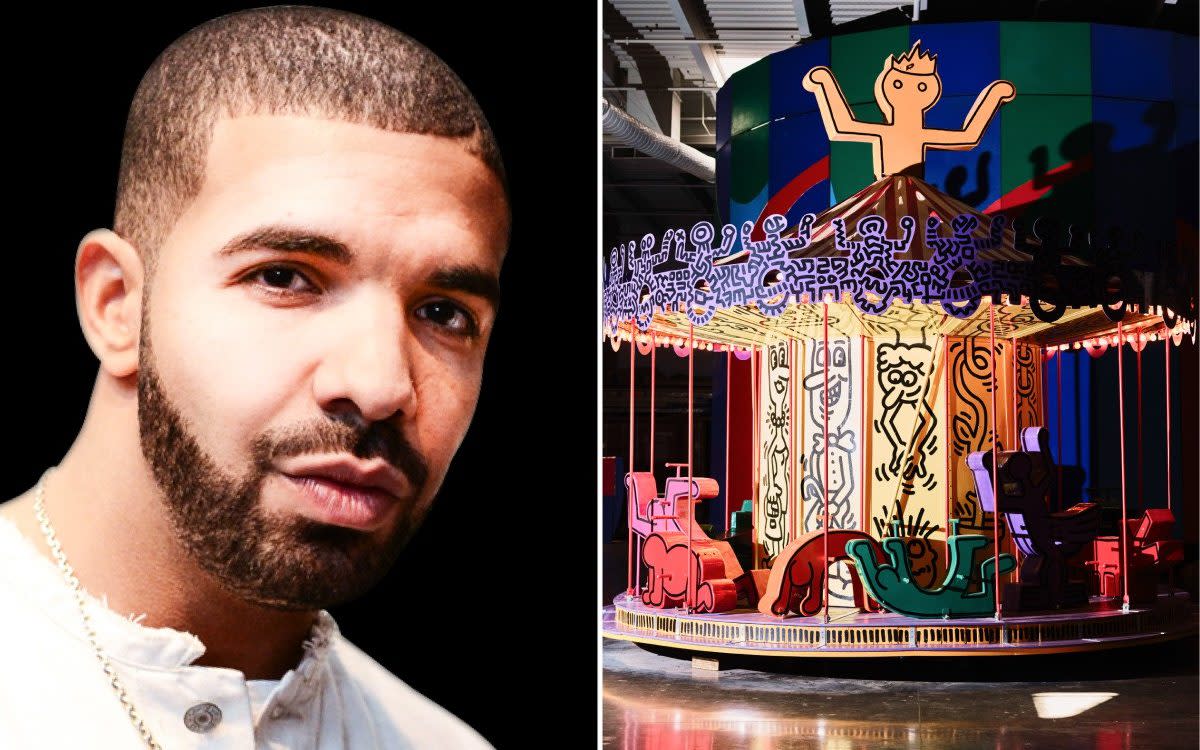
- Oops!Something went wrong.Please try again later.
‘Isn’t it magical?’ asks the lawyer-turned-impresario Daniel McClean, gazing at a Ferris wheel slowly revolving in a dark warehouse in downtown Los Angeles.
As the 512 amber light bulbs attached to its metal spokes and rim switch on, the effect, it’s true, is spellbinding and otherworldly, stimulating a surge of nostalgia for half-remembered fairground rides experienced during childhood.
‘This,’ says McClean, with a showman’s flourish, ‘is your playground for the next few days.’
Yet, for me, even more captivating are the big wheel’s off-white panels, reproducing scratchy, enigmatic drawings of sundry, surprising things: flies buzzing around heaped spaghetti; levitating molars still attached to their roots; top hats and bolts of lightning; a flame-grilled chicken on a spit.
A vast likeness of a baboon’s hairy hindquarters, on a pair of plates high above the structure’s steps, dominates everything. Its erect, cut-out tail ensures that this primate’s puffy purple buttocks (and anus) are conspicuously exposed.
Scruffy yet elegant, runic but somehow refined: this astonishing imagery could only have tumbled from the imagination of the prolific American wunderkind Jean-Michel Basquiat, who emerged in New York in the late 1970s, and died, aged only 27, in 1988. Did you know that Basquiat had designed a Ferris wheel? Me neither.
Yet, the story of its genesis as part of Luna Luna – a long-forgotten amusement park that materialised in Germany over a single summer in 1987, with attractions by illustrious modern artists (including, besides Basquiat, Salvador Dalí, Roy Lichtenstein and David Hockney) – is one of the most riveting that I’ve come across in two decades of writing about art for this newspaper.
Recently, Basquiat’s Ferris wheel, along with several other rides and amusements likewise unseen since their debut in that park, was unveiled in Luna Luna: Forgotten Fantasy, an exhibition in the same 60,000 sq ft complex of two warehouses in Boyle Heights that I visited last month, while preparations for it were underway.
In a further twist, the venture has been chiefly funded by a company co-founded by Drake, the Canadian musician and hip-hop superstar. ‘There’s still a lot of work to be done!’ says McClean, with a delirious laugh, as cherry-pickers and forklifts beep busily around us, and conservators give the exhibits a final spit and polish. Then, he begins to relate Luna Luna’s mesmerising yarn in full.
At the centre of this saga is another charismatic figure, besides Drake: the Austrian polymath André Heller, a poet, pop star, peace activist and ‘fireworks specialist’, who – enchanted by memories of Vienna’s Circus Rebernigg and Prater park, which, he once recalled, had enlivened growing up in the ‘grey, bombed-out’ city of his birth – first conceived of an amusement park designed by artists almost 50 years ago, in 1974.
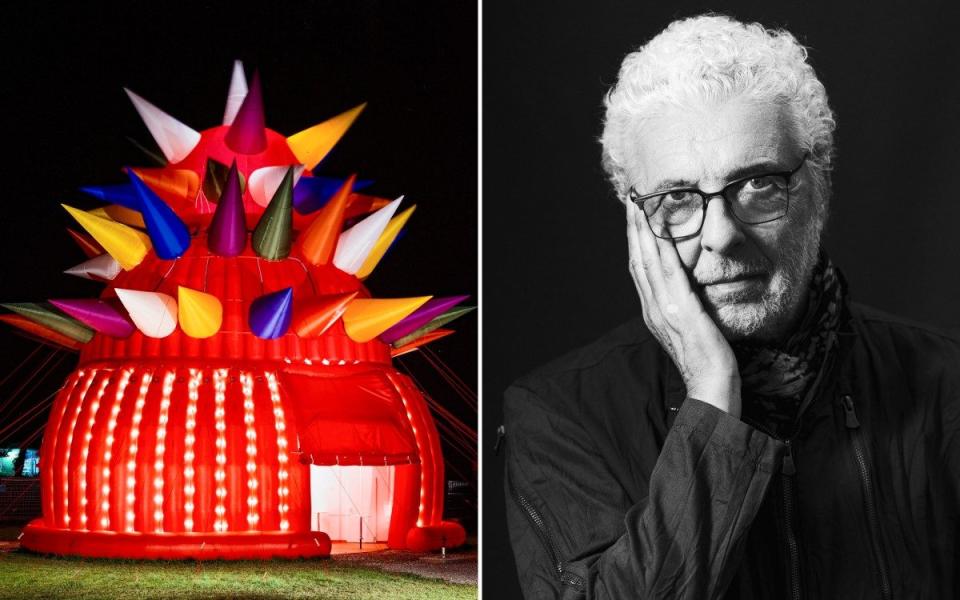
(Heller, who is now 76, and was involved with Luna Luna’s revival, wasn’t available to speak to me for this article: last year, he parted from the project, after a scandal erupted concerning a faked Basquiat picture frame that he’d sold, he says, as a ‘childish prank’ – but for which he is no longer being investigated by prosecutors in Vienna.)
In 1976, Heller visited the great Ukrainian-born French modernist Sonia Delaunay at her Paris studio, and convinced her of his idea’s brilliance; inspired, she produced a large triumphal arch (reassembled for the exhibition in LA), dynamically decorated with colourful triangles and target-like discs and semicircles. With such a prominent figure on board, momentum for his concept could gather.
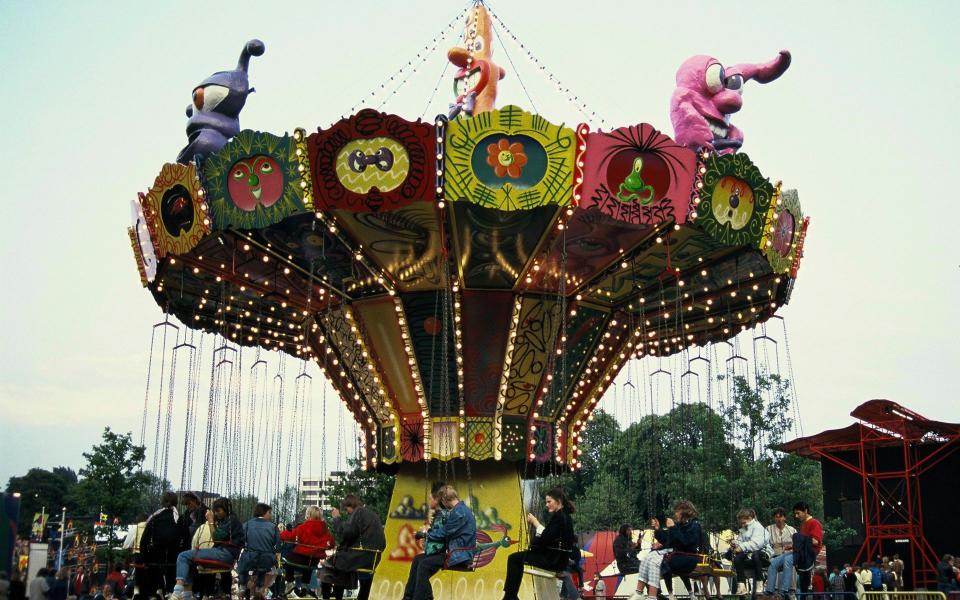
Apart from the American composer John Cage (reportedly the only person who turned him down), all of the artists Heller signed up were delighted by his playful vision – even though the fees on offer (of around $10,000 each) were, he later recalled, ‘ridiculously low’.
They were funded by sponsorship that he secured, in 1985, in the form of a $350,000 (around $1 million today) grant, from Neue Revue magazine’s German publisher. (According to weekly news magazine Der Spiegel, Heller declined backing from McDonald’s, because, as he put it, ‘We don’t want to set up a Disneyland.’)
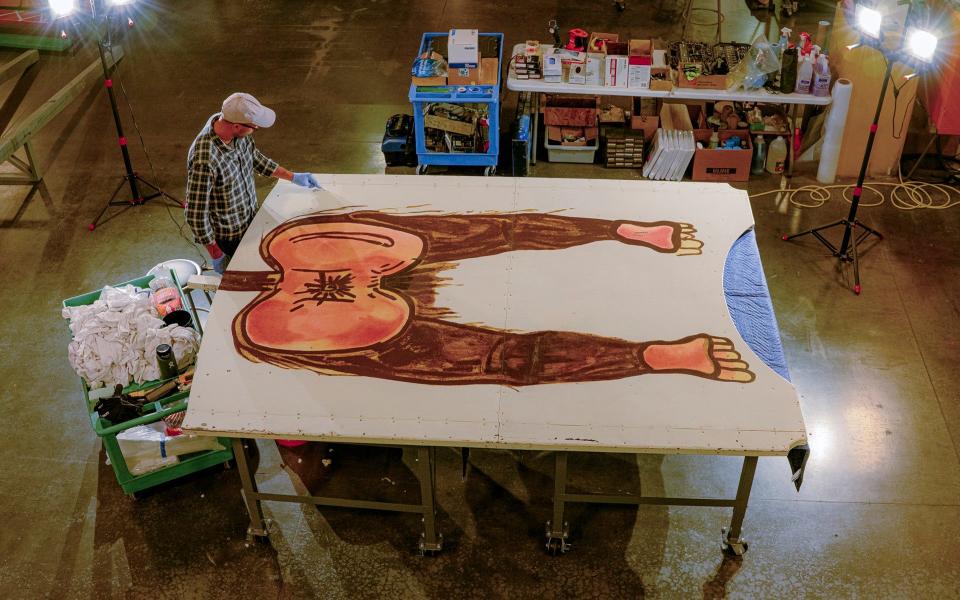
The money also covered a 200-strong team of carpenters, electricians, painters, welders, model-makers, structural engineers, and architects, who constructed what Heller has described, in a book about the project released this year by Phaidon (reissuing an original publication from 1987, translated, for the first time, from German into English), as ‘a small transportable city that could withstand the onslaught of hundreds of thousands of onlookers’.
Eventually, in early June 1987, Luna Luna – named after the original Luna amusement park in Brooklyn’s Coney Island – opened in a public park in Hamburg. Over almost three months, it was visited by nearly 300,000 people. Heller’s dream of connecting the avant-garde with a mass audience had become reality.
Photographs taken by Sabina Sarnitz, who documented Luna Luna’s creation, provide a sense of why, at the time, Life magazine described the finished park as the ‘most dizzying, dazzling art show on Earth’.
After passing through Delaunay’s triumphal gateway, visitors beheld an enticing, harlequin array of around 30 rides, sideshows, funhouses and booths. Off to the right, inside a pavilion designed by Roy Lichtenstein, members of the public listened to music by the composer Philip Glass; to the left, Heller’s billowing red Dream Station, an inflatable tent-cum-sculpture, sewn from balloon silk (and with multicoloured cones protruding from its upper sections, like a jellyfish’s arms and tentacles, or a sea urchin’s spines), appeared like an eldritch vision of a pumpkin, and housed a café.
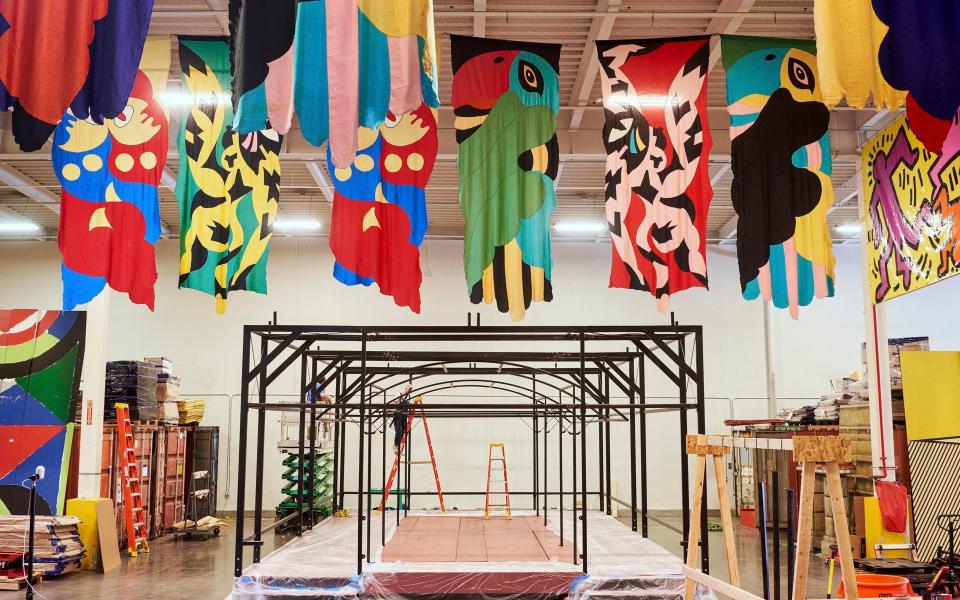
Dead ahead was the drum-like tower of David Hockney’s Enchanted Tree, its 26ft-high façade painted with a simple, Matissean fairy-tale-forest design of crimson branches and patches of foliage in blue and green, all ingeniously interlocking in the manner of a child’s jigsaw puzzle. Inside, within another, concealed cylinder, a recording of a concert by the Berlin Philharmonic, conducted by Herbert von Karajan, could be heard.
Beyond this, there was Basquiat’s Ferris wheel (rotating, at his request, to Miles Davis’s song Tutu); and a carousel, as colourful as a set of crayons, flanked by four mural-like tarpaulin banners by the American Keith Haring, who was part of the same scene, and likewise died young. In a charming touch, the carousel, which McClean calls Luna Luna’s ‘gem’, includes a self-portrait of the bespectacled artist, who travelled to Europe to work on it, wearing Adidas trainers.
Elsewhere, there were shooting galleries; a House of Shadows, with a painting by the German artist Georg Baselitz; a building that echoed with the sounds of mating whales; and, next to the mirrored, geodesic Dalí Dome, a Palace of the Winds, which featured the bared, spot-lit buttocks of performers trumpeting an irreverent accompaniment to classical music into microphones on a small stage.
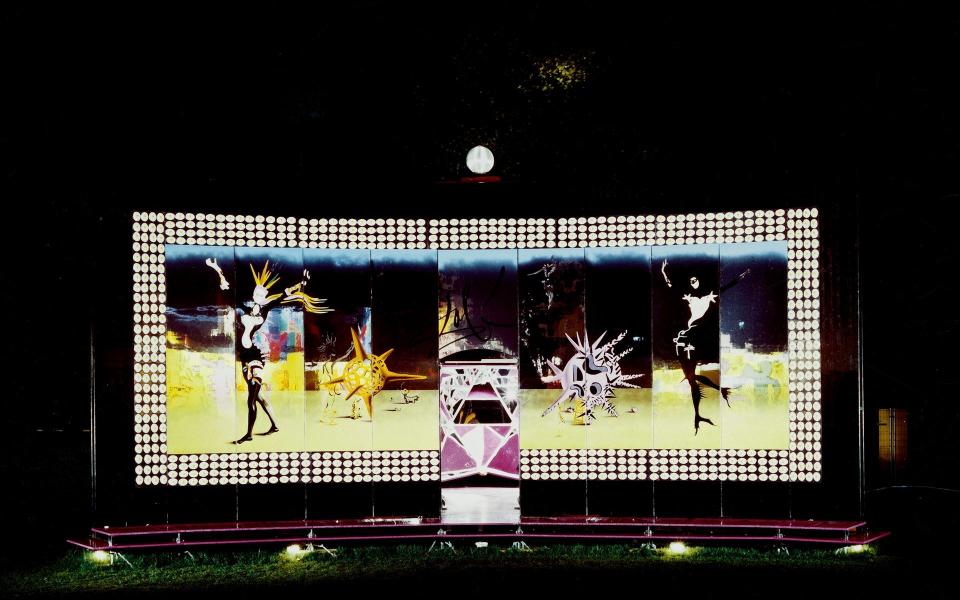
The threshold to the public toilets, dreamed up by the Swiss artist Daniel Spoerri, was a satirical façade in the style of Hitler’s Reich Chancellery, before which a pair of columns supported models of heaped-up excrement.
That Luna Luna, a movable, open-air museum of modern art, happened at all was, frankly, a coup; unsurprisingly, given his ambitious nature, Heller had grand plans that, following its debut, it would travel the world, like an itinerant circus. This, however, never happened, and, as storage costs spiralled, he decided to sell his Gesamtkunstwerk wonderland.
In 1990, he agreed a deal worth about $6 million with a philanthropic foundation in America that hoped to tour Luna Luna, starting in Balboa Park in San Diego. When, though, negotiations with the Californian city’s officials fell through, the foundation tried to withdraw – and, says McClean, who specialises in art-restitution law, ‘17 years of litigation’ ensued.
‘Eventually,’ he continues, a court in Delaware ‘enforced an arbitration judgment in Heller’s favour that forced the [Stephen and Mary] Birch Foundation to complete the sale’; and, around 2007, Luna Luna, disassembled and packed into dozens of shipping containers and crates, ended up in a ‘storage facility… in the middle of rural Texas’.
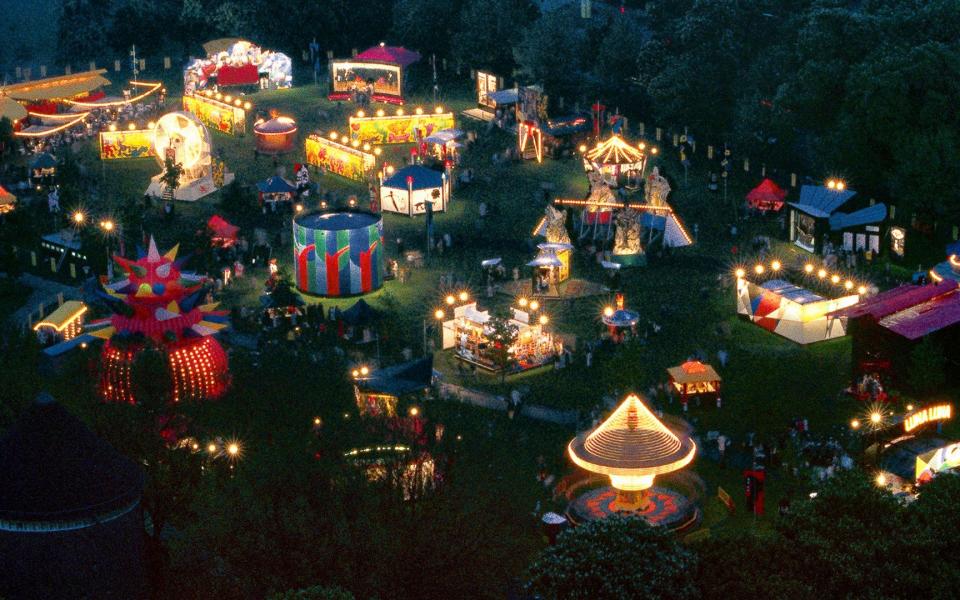
There, it languished for a decade or so, until McClean arrived with a friend, the art historian and Basquiat scholar Dieter Buchhart, who’d tipped him off about it, to have a sniff around. After glimpsing several ‘extraordinary works’ within three previously ‘unopened’ containers, McClean recalls ‘standing in this Texas field’, experiencing ‘my moment of revelation, my epiphany’.
‘I became obsessed with it,’ he grins. He decided to form a company, Lunatopia, with Heller, Buchhart and the tech entrepreneur and art collector Justin Wills, to rescue Luna Luna from its Southern limbo and bring it back to life.
Soon afterwards, in 2019, and unbeknown to them, the creative director (and founder of Something Special Studios) Michael Goldberg also came across Luna Luna’s story, in an obscure post online.
Captivated, he brought it to the attention of DreamCrew, the media and entertainment company co-established by the renowned rapper Drake, who said in a statement published last year by The New York Times that he was immediately ‘blown away’.
(Drake, for whom Damien Hirst once designed an album cover, collects art; a music video, which the rapper released during the pandemic, revealed a mansion empty of people but decorated with modern and contemporary pieces including a painting of Mao Zedong, by Andy Warhol, and sculptures by another American, KAWS.)
With Drake willing for DreamCrew to be, as McClean puts it, ‘principal investor’, one of its partners, Anthony Gonzales (who is now Luna Luna’s chief executive), along with Goldberg, joined forces with the Lunatopia team, and negotiated to buy the park.
According to McClean, a condition of the sale was that ‘everything’ had to be bought ‘as-is, unseen’ – a risk, he laughs, ‘I wouldn’t advise my clients to [take] normally.’
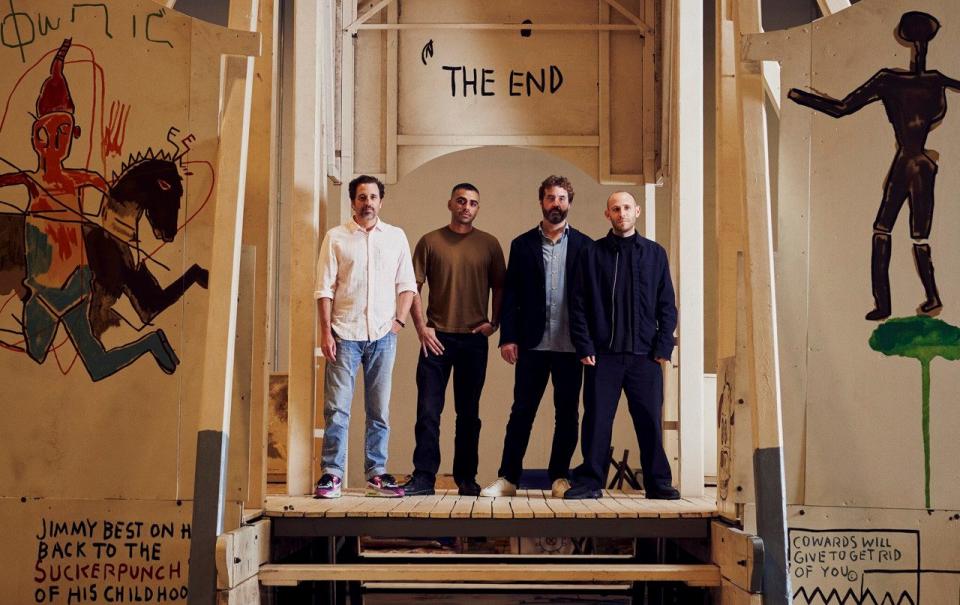
After, though, 44 containers arrived in Los Angeles over three days at the start of last year, it became apparent, McClean continues, that, aside from the intrusion of a few rattlesnakes and scorpions, the various rides and related ephemera (including an unforeseen cornucopia of original merchandise, such as posters and T-shirts) had been ‘very well packed [and] preserved’. A suggestion, reported by The New York Times, that, in 2018, he’d encountered water ‘sloshing out’ from one of the containers is, he tells me, ‘hearsay’.
What followed, says Luna Luna’s studio director Joel Searles, was the ‘long process’ of ‘figuring out how to put [everything] back together’; a process complicated by the fact that, ‘there is no manual […] so, when you’re pulling stuff out of a container, it’s almost just a puzzle’.
During my visit, three weeks before the show’s opening, the painstaking task of cleaning the exhibits is still ongoing: a woman atop a scaffold tower deploys ‘conservation-grade detergent’ to remove sludgy grey specks from a bopping purple figure in one of Haring’s painted tarps.
Elsewhere, some more permanent damage is evident. Lichtenstein’s 37ft-long pavilion, for instance, has suffered what McClean calls ‘minor discoloration’ (unprotected in ’87, its ‘pristine white’ background, against which the artist’s fractured, starburst-like forms once appeared, is now a nicotine stain’s yellowish-brown); there are, says McClean, plans ‘to recreate it at some point, in consultation [with] the Lichtenstein estate’.
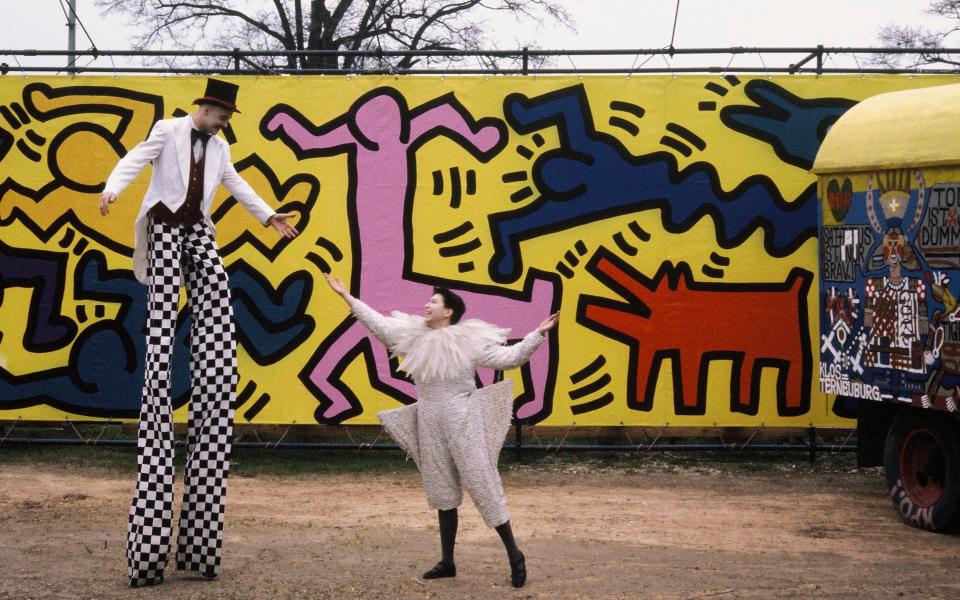
Scuffmarks are visible, too, on the exterior of Hockney’s Enchanted Tree, which also contains a tarpaulin ceiling speckled with bare patches of paint-loss. This, explains Searles, was ‘due partially to how it was packed, but also to the materials they used at that time: paint doesn’t really stick to a vinyl tarp, especially after 35 years in a container. But, given that, it’s still in a pretty good condition.’
In general, he explains, the ‘philosophy’ was to clean things wherever possible and necessary, but never to give a misleading impression of immaculateness. Referring to the rides, Luna Luna’s collection manager, Autumn Beck, confirms that ‘we really wanted to keep the patina of their original use, and not try to make them some perfect thing’.
If anything, this abraded ‘patina’ only adds to Luna Luna’s appeal; walking among the already installed rides last month, a sense of slightly creaky mystery, and playful excitement, was palpable. In 1987, Beck tells me, much of the music within the park ‘was, literally, like, a tape box strapped to the back of a ride’.
‘It’s very lo-fi,’ agrees McClean. ‘That’s what’s charming about it.’
Still, restoring Luna Luna’s on-a-shoestring simplicity hasn’t come cheap. A spokeswoman for DreamCrew refuses to confirm what it cost to acquire Luna Luna. How much, then, has been spent in total, including the acquisition and getting to where we are today, with rides restored, an exhibition open to the public and outlay on the park’s future?
‘My God,’ says McClean, after a pause. ‘A lot.’ He won’t elaborate further, but does not dispute last year’s suggestion, in The New York Times, that ‘overall investment in Luna Luna is approaching $100 million’.
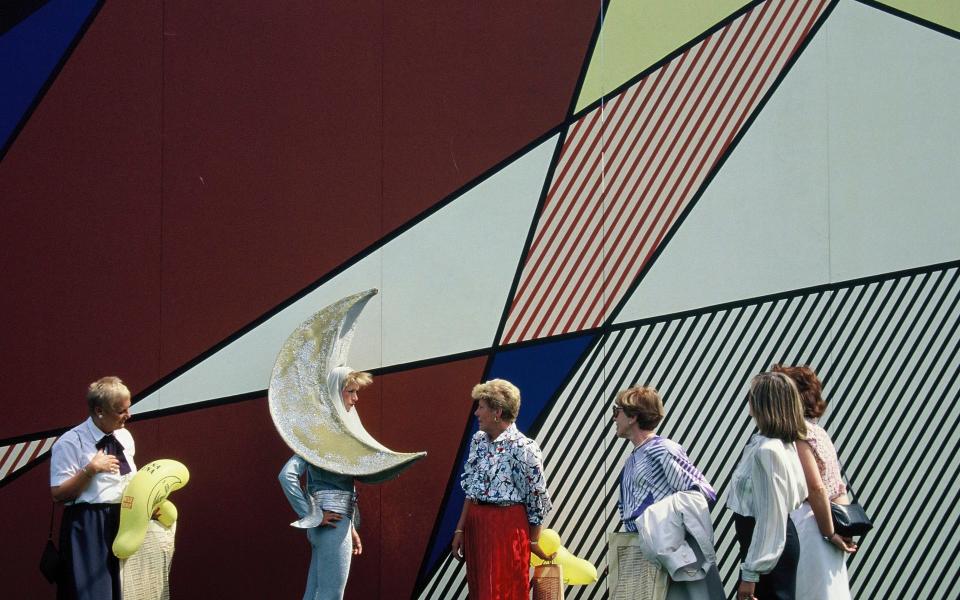
For that sort of money, you might think all the reassembled attractions would be up and running. Not so. During the exhibition, mechanical rides, such as Haring’s carousel, will be off limits. ‘These things probably weren’t safety-compliant in the 1980s,’ explains McClean. The Ferris wheel embellished by Basquiat, for instance, dates from 1930: ‘It’s already antique,’ McClean continues, ‘so, in terms of health and safety, no way; also, in terms of their fragility, and value, as artworks, it’s not possible, sadly.’
Yet, he adds, for ‘VIPs’, ‘immersive experiences’ will be permitted inside the Dalí Dome and Hockney’s Enchanted Tree. The latter, which, McClean says, ‘Hockney remembers vividly, and was very fond of’, could even be considered as ‘a prototype for his immersive projects now’ – such as his ambitious autobiographical projection Bigger & Closer (not smaller & further away), which closed recently in London, following a nine-month run.
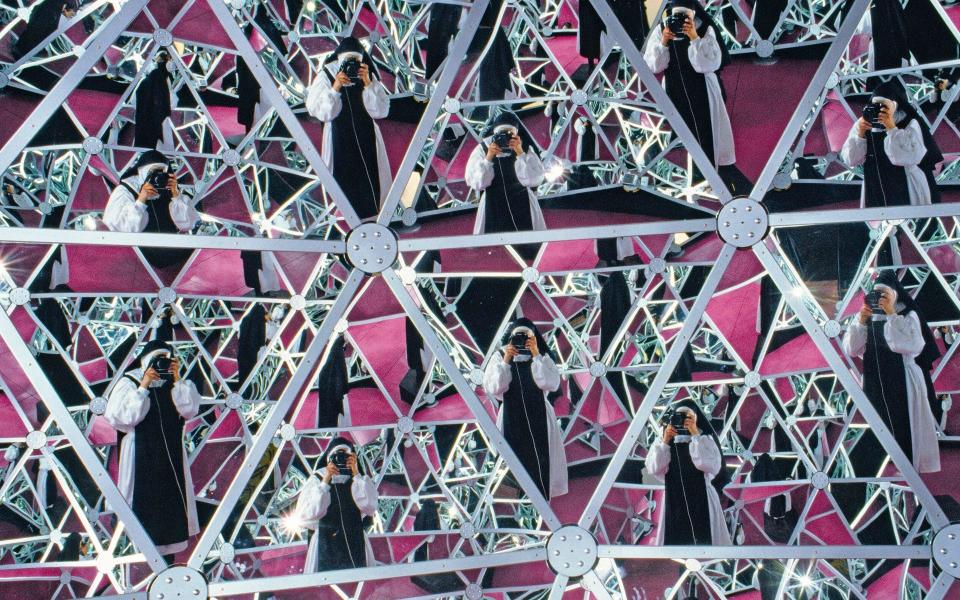
How, then, should we think about Luna Luna’s various attractions today: are they rides – or artworks? ‘That’s one of the things I’m most interested in about the project: their status as art objects is very up in the air,’ says Helen Molesworth, Luna Luna’s curatorial adviser. ‘Sometimes I wonder if we’re watching the transformation of what was once an amusement park into a sculpture park.’
Acknowledging frustration that visitors can’t experience the historical rides, McClean and his co-partners – who hope to cash in on the vogue for ‘immersive’ art – are weighing up various opportunities to monetise Luna Luna beyond the initial exhibition in LA.
Recently, they have been talking to several contemporary artists from whom they intend to commission new, interactive rides, for future iterations of the park – including the German Carsten Höller, who, McClean tells me, ‘saw the original [Luna Luna], [which] was very influential for him’.
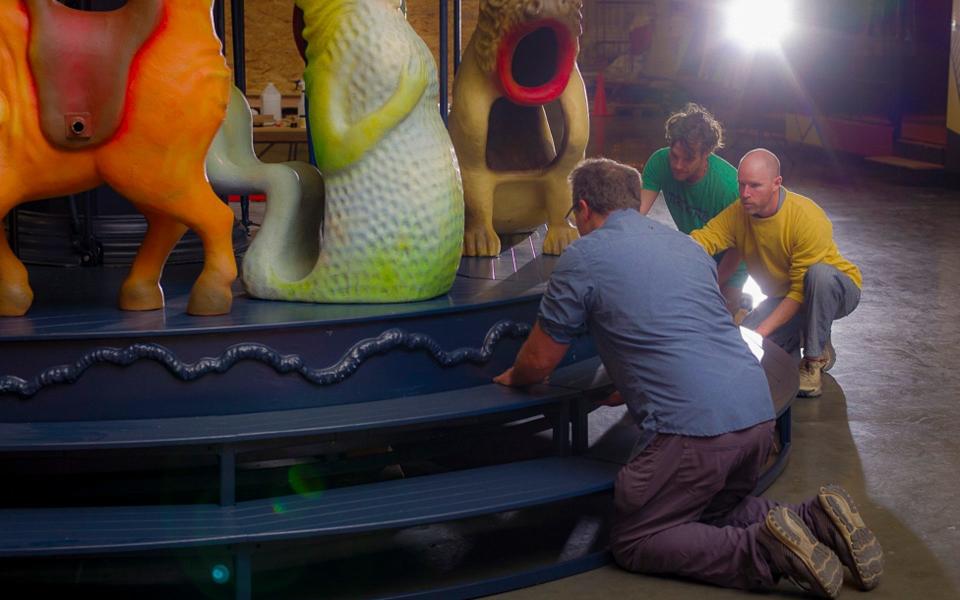
(Today, Höller is fêted for his own amusement-park-ride artworks, including gleaming, slowed-down carousels, and a set of five twisting metal-and-fibreglass slides that he installed at Tate Modern in 2006.)
Höller’s principal memory of Luna Luna was ‘soggy feet – because it rained all the time’, says McClean, who shows me some of the white umbrellas, still wrapped in plastic, which turned up unexpectedly within those containers in LA.
Despite inclement weather, then, Luna Luna, continues McClean, ‘totally changed [Höller’s] life’ – and Molesworth, who has also been involved in commissioning ‘new pieces’, describes a similar effect upon ‘artists today’. ‘Every artist I brought in [to Luna Luna’s LA warehouse]… left with cartoon stars spinning around their head.’
Long before Heller was born, the son of a wealthy sweet manufacturer, in 1947, an obsession with circuses and the fairground (along with a preoccupation with childish modes of creativity and play) had become a trope in modern art.
Yet, for Molesworth, Luna Luna’s ‘stupendous’, ‘prescient’ scope was unprecedented: ‘The wholesale takeover of a popular form, a carnival or a Luna park, by a group of artists? No, I don’t see that anywhere else.’
Initially, when she first heard about it, all she wanted to know was: ‘How was [Heller] able to pull this off?’ So, she travelled to Vienna to interview him, ‘and, within an hour, I was like, “Oh, I know how you did this: you’re totally seductive.” He’s charming and poetic and a little slippery: he’s a player, as we would say.’
Increasingly, though, as she engaged with the park’s artistic content, she discovered nuance and complexity, as well as ‘avant-garde impulses’ – and now she describes Luna Luna as a quintessentially post-war project, shot through with 20th-century traumas.
‘Heller sees culture as the ultimate bulwark against fascism, violence, [and] prejudice,’ she explains.
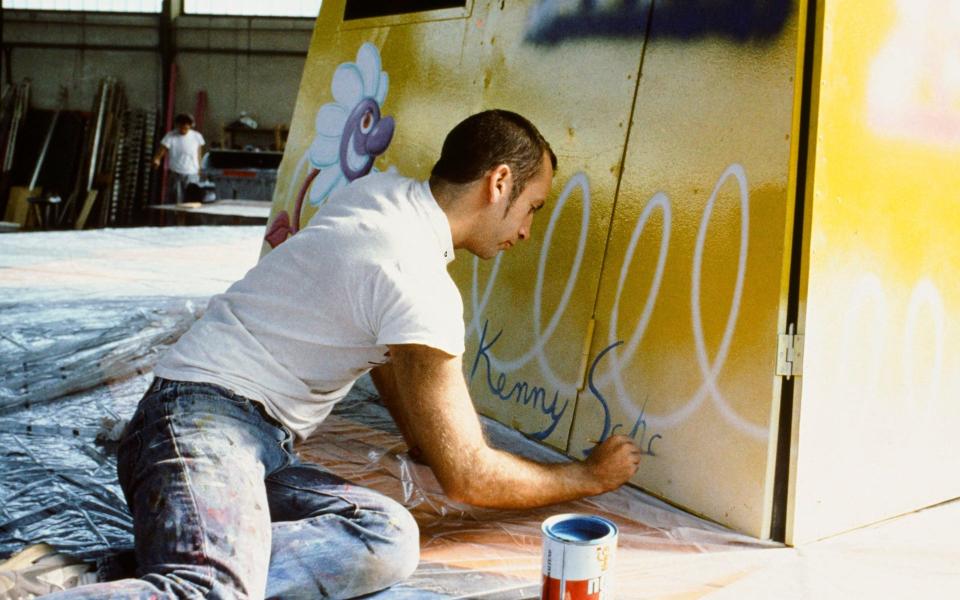
Certainly, for all its accessibility and sense of fun, Luna Luna, which can be unapologetically high-minded, is shadowed by darkness. Behind the scenes, I spot a life-size model of an anthropomorphised pig half-hidden by a sheet: dressed in a tailcoat and bowtie, he holds a stubby cigar suggestively by his crotch.
How he fits into Luna Luna remains a mystery: ‘We don’t know what this crazy figure belongs to,’ McClean tells me. ‘It’s rather obscene and creepy.’ Yet, somehow, this grimacing swine seems to embody Luna Luna’s anarchic spirit.
Likewise, the first ride encountered by visitors to the exhibition: a carnivalesque merry-go-round by the Austrian artist Arik Brauer, with seats shaped like sinister fairy-tale characters: witch’s familiars, misshapen merfolk, a pointing hand with hooves. These abortive, fantastical beings could have been dreamed up by Hieronymus Bosch.
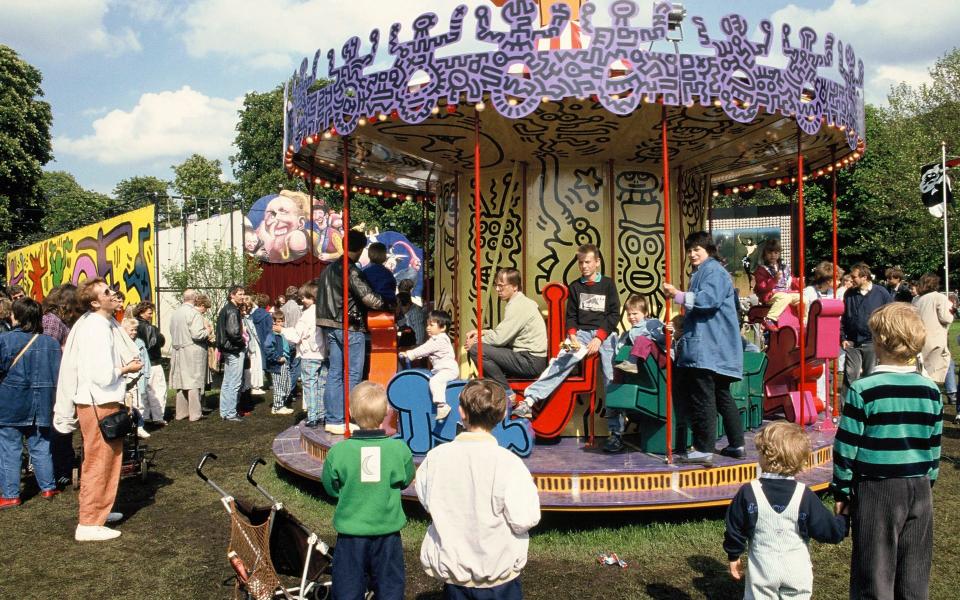
Even Keith Haring’s imagery, which, at first glance, seems so upbeat and life-affirming, teems with monsters and violence: crocodiles and twin-headed or triple-eyed creatures; a green man whose torso has been sundered, explosively, from his legs; an upside-down figure, with an ominous cross for an eye, like the reversed Tarot card of Death; a character emerging, demon-like, from another’s belching maw.
Which brings us back to Basquiat’s Ferris wheel, with its gondolas, beneath curving white canopies, resembling skulls, and abundant, allusive imagery offering a bewildering commentary upon tensions within North American society.
‘Pornography’, ‘Hatchet’, ‘Bleeding Fingers’: each cabin is identified by a single word or phrase, reproduced in Basquiat’s distinctive handwritten style; nearby, ‘Jim Crow’ refers to racism in the United States.
None of this, for an amusement park, is very amusing. But doesn’t that make its presence, in such a setting, compelling, even profound? As Heller once said, referring to Luna Luna: ‘We encounter evil images and hauntings along with laughter and ridicule.’
I loved my time in his topsy-turvy La-La Land, but my experiences there also proved unsettling. That powerful ‘magic’ of which McClean speaks may be less benign than it, at first, appears.
Luna Luna: Forgotten Fantasy is on view in Los Angeles until May 2024; lunaluna.com
Original photographs by Sabina Sarnitz

